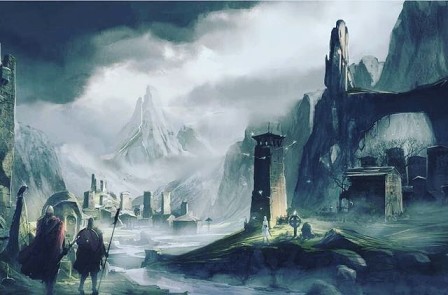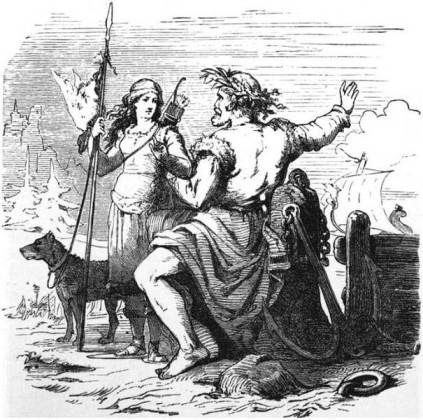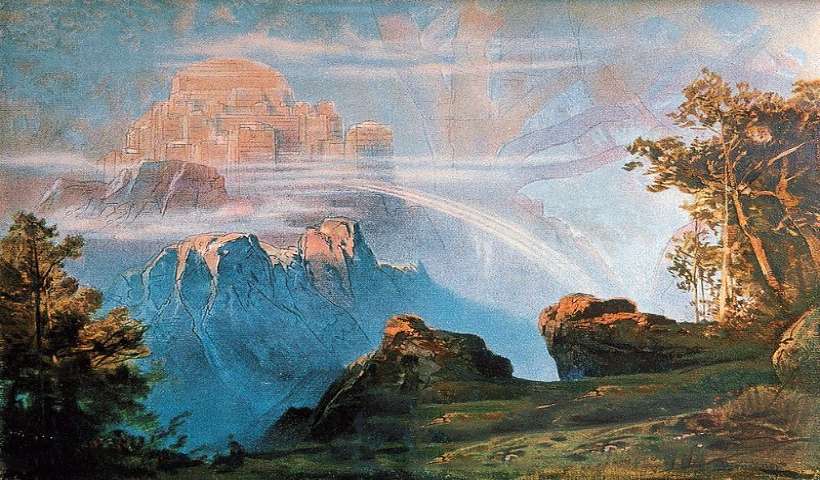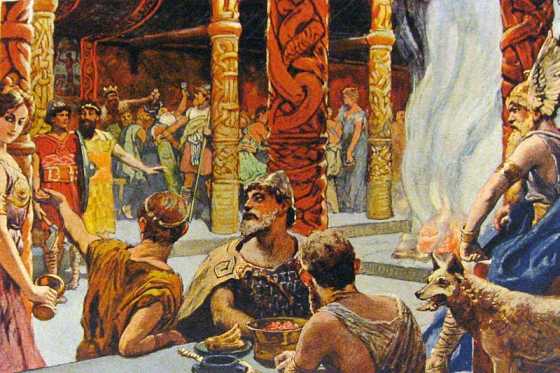In Norse mythology, there are many gods, and and almost as many halls. A god must have a dwelling place worthy of their station. Across Asgard the gods have a number of great halls to hold banquets in, celebrate their victories, grieve fallen warriors, or simply drink and feast as they might.
The greatest of the gods celebrate their high deeds in halls that are known far and wide throughout the nine realms. These are the most famous of them.
Bilskirnir, ‘Lightning Bolt’, Hall of Thor
Thor, the strongest of all the gods holds a court in a building known as the Bilskirnir. This is not only the largest of the halls in Asgard, but the largest structure ever created in any of the nine realms. The Bilskirnir is not merely a hall, it has in fact no less than 540 rooms in total.
Holy is the land,
which I see lying,
to Æsir and Afar near;
but in Thrudheim
Thor shall dwell
until the powers perish
(The Grimnismal, Olive Bray Translation)
Thor dwells here with the lovely Sif and their children. Their abode is in the district of Asgard known as Thrudvang meaning ‘World-strength’. Sometimes the name of Thrudvang, Thrudvangr, or Thrudheimr is given to the halls themselves.
Breidblikk/Breidablik, ‘Broadview’, Hall of Baldr
Also meaning ‘broad-gleaming’, Baldr’s home shines as brightly as the god himself, illuminating the heavens far and wide.
He dwells in the place called Breidablik,
which is in heaven;
in that place may nothing unclean be
(Snorri Sturluson, The Gylfaginning)
Baldr’s hall is the most beautiful of all the homes of the gods and no unclean thing or ‘baneful rune’ may cross its threshold.
Sadly, the most beloved god of all no longer resides in this beautiful hall and his wife Nanna remains there alone pining for the loss of her husband.
Eljudnir, ‘Damp with Rain and Sleet’, Hall of Hel
Odin granted the rule of Helheim, the netherworld to Loki’s daughter Hel. Therein she constructed a doleful hall, named Eljudnir, amid the snowstorms, sleet, and rain of Niflheim. The walls are high and her tables long to accommodate the dead with whom she feasts.

To reach the hall of the dead a soul must journey downwards to find the golden bridge of Gjallarbru, the bridge over the river Gjoll. This bridge is guarded by a jotunn maiden named Modgudr, ‘war-frenzy’. She decides who shall enter and prevents any departures.
Once the river Gjoll, ‘scream’, has been traversed the soul is close to the gates of Eljudnir which are guarded by the fearsome bloodstained hell-hound Garm. Between Garm, Modgudr, and Hel herself, not even the gods may leave this place one entered.
The threshold to her home is a pitfall named the Fallandaforad, or ‘falling to peril’. She sleeps there in a bed named Kor or the ‘sick bed’. The bed is guarded by long curtains called Blikjandabol, or ‘gleaming disaster’.
When Hermod the brave messenger visited Helheim in search of Baldr, he found him seated next to Hel in Eljudnir. The downcast god sits there still awaiting Ragnarok and the release of the denizens of the underworld for the final battle of the gods.
Fensalir, ‘Fen Halls’, Hall of Frigg
Frigg, foremost of all the goddesses and wife to Odin, has a hall unto herself apart from that of her husband. This goddess of prophecy and the mysteries of womanhood was often worshipped in places of mist and magic associated with wetlands, fens, and bogs.
Her fine home is therefore situated amid the wetlands of Asgard and it is here that Loki came, disguised as a maiden to discover the secret of Baldr’s invincibility.
It is here also that Frigg mourned the death of her son and now awaits vengeance for his murder.
while Frigg wept
in Fen Halls
for Valhall’s woe
(The Voluspa, Anthony Faulkes Translation)
Gimli, ‘Fire-shelter’, Hall of the Gods after Ragnarok
During the devastation of Ragnarok, the ranks of the gods will be decimated, and their vast halls razed to the ground. Thor, Odin, Heimdall, Loki, and many more shall perish and make their final journey to the afterlife.
The gods who survive the battle will build anew and construct a vast, beautiful hall that will be the most beautiful place in the nine realms. The building will be roofed with pure gold and will shine more brightly than the sun.
The righteous and the goodwill all travel to his heavenly place after their time on earth is complete
Gladsheimr, ‘Bright Home’, Hall of Odin and the Gods
The gods and goddesses of Asgard each have a hall where they can meet without the interference of the opposite sex. The Gladsheimr hall is where the male gods have their high council seats and is presided over by Odin.
Not all the gods have a place in this inner circle with only thirteen places reserved for the greatest and wisest among them. The hall is built upon the Idavollr or ‘splendor plain’ and is not far from the hall of Vingolf where the goddesses have their meetings.
At Ithavoll met the mighty gods;
Shrines and temples they timbered high;
Forges they set, and they smithied ore,
Tongs they wrought, and tools they fashioned.
(The Voluspa, Henry Bellows Translation)
After Ragnarok, the plain of Idavollr is where the surviving gods will meet to construct the shining hall of Gimli.
Glitnir, ‘One Who Shines’, Hall of Forseti
Forseti, son of Baldr and Nanna, god of justice, has his own shining hall with golden pillars and a roof of gleaming silver. When he was still alive and in Asgard Baldr would sometimes also dwell here with his wise and gentle son.
The hall is a place where the gods and goddesses of Asgard, under the wise council of Forseti, can wrangle their disputes and come to common agreement without violence.
Himinbjorg, ‘Heaven’s Castle’, Hall of Heimdallr
Himinbjorg is the home of Heimdallr, guardian of the Bifrost. The ever watchful god sups his mead in this place, situated at the meeting point of the bright rainbow bridge and the land of Asgard.
Himingbjorg is the eight, and Heimdall there
O’er men hold sway, it is said;
In his well-built house does the warder of heaven
The good mead gladly drink.
(The Grimnismal, Henry Adams Bellows Translation)
Landvidi, ‘Broad Land’, ‘White Land’, Hall of Vidar
Vidar, son of Odin and the giantess Gridr, occupies this wide hall. Thor, the strongest of all the gods has a hall that is greater in size than all others. Vidar is second in strength only to Thor and likewise has a home that is vast in size.
It is said that he lives with his mother Gridr in this place and that the hall is overgrown with wild grass and brushwood. One day Vidar will ride out from Landvidi to avenge his father’s death by the jaws of Fenris. After the battle, he will help rebuild the new heavenly world with the other survivors of Ragnarok.
Noatun, ‘The Place of Ships’, Hall of Njord
The Place of Ships is home of the Vanir god Njord. Although not a native Aesir, Njord lives in Asgard as part of the peace treaty and hostage exchange at the end of the great war between the gods. His home is therefore in Asgard and lies at the water’s edge being a safe haven for ships and seafarers.

When Njord was briefly married to the jotunn maiden Skadi, he dwelt for a time in her mountain home but could not bear the cold. Skadi agreed to live with him in Noatun for a time, but she also could not abide his home and the two parted ways.
Sessrumnir, ‘Seat-room’, Hall of Freya
Valhalla is well known to all as the hall of heroes who feast with Odin in the afterlife. Lesser known is Sessrumnir, the seat-room where Freya feasts with her share of the warriors slain in battle in Midgard. Each day, those who have fallen in battle are divided, half go to Odin, the other half to Freya.
Those chosen by the Vanir goddess of love and war are greeted by her in the ‘field of the host’, the Folkvangr. There they learn their destiny and are welcomed into Sessrumnir to feast until the time of Ragnarok calls them to battle once more.
I have to caveat this by adding that it isn’t actually certain that half the fallen warriors went to Folkvangr. There are some holes in that theory you should read up on.
Valhalla is a boisterous place where the warriors fight to the death each day, only to be born again on the next to eat, drink and fight all over again. By contrast, Sessrumnir is filled with the sounds of heavenly music and is a place of great beauty.
Sokkvabekkr, ‘Sunken Benches’, Hall of Saga
The goddess Saga is gifted with second sight. Odin, a lover of wisdom, visits her daily to sup with her and listen to her songs of heroes and great deeds. Saga holds court in a great hall at the water’s edge and it is here she sits with the Allfather, the sound of waves mixing with her sweet voice.
Sökkvabekk is the fourth, where cool waves flow,
And amid their murmur it stands;
There daily do Othin and Saga drink
In gladness from cups of gold.
(The Grimnismal, Henry Adams Bellows Translation)
Thrudheimr/Thrudheim, ‘World of Strength’, Hall of Thor
Thrudheim is another name for Thor’s vast abode, also known as Bilskirnir. It is the largest of all the halls of the gods as well as the largest building ever constructed in all the nine realms. There Thor lives with his wife Sif and daughter Thrud.
Thrymheim, ‘Thunder-home’, Hall of Skadi
Skadi lives with her jotunn father Thiazi in the snowy mountain hall of Thrymheim. It is here that Njordr resided for nine nights before she came to spend her time in his hall of Noatun. As neither could abide the other’s home the lovers went their separate ways.
Njordr complained of the howling of the wolves compared to the gentle song of the swans in his home.
“Hateful for me are the mountains,
I was not long there,
only nine nights.
The howling of the wolves
sounded ugly to me
after the song of the swans.”
(The Prose Edda, Jesse L. Byock Translation)
Valaskjalf, ‘Shelf of the Slain’, A Hall of Odin
Odin, with his high responsibility for all the nine realms, has many halls according to his needs. The Valaskjalf has a roof of pure, shining silver and is situated in a high place. It is home to a tower in which lies the Hlidskjalf throne. The Allfather can see everywhere throughout the worlds from this vantage point.
Valhalla/Vallholl, ‘Hall of the Slain’
Valhalla belongs to Odin and is arguable the best known of all the halls in Norse mythology. This is where the heroes of Midgard are taken after their death on the battlefield. The hall is located on the plain of Gladsheim.

The hall of Valhalla is so tall that it is scarcely possible to see its gleaming shield-covered roof. The shields are made of gold and constantly reflect the light of the Idavollr ‘ splendor plain’. The high rafters of the hall are made of battle spears, and the heroes’ chairs are forged from breastplates.
Entry is not granted to all and wolves, sacred to Odin, guard its main entrance, the Valgrind, or ‘Death’s Gate’, while protective eagles soar high above its roof. The hall is a forbidding location to all who would assail it, should any enemy be foolhardy enough to try.
The Einherjar
As heroes are ever dying upon the field of battle, Valhalla is thronged with heroes who require the constant flow of mead, meat, and entertainment. These warriors are known as the Einherjar and are the adopted sons of Allfather Odin in whose house they now reside.
Each day the heroes do battle, honing their skills while enjoying their sport. At the end of each day, all wounds are healed so that the feasting might begin anew.
It is here that Saehrimnar the boar is butchered and cooked for the masses of heroes every evening by Andhrimnir, the chef of the gods. For their drink, they are supplied by the udders of the goat Heidrun who brings forth an endless supply of the sweetest mead.
Odin himself sits with the Einherjar at their evening feast but eats no meat himself. The Allfather casts the portion he receives to his wolves and only contents himself with mead to satisfy his need for sustenance.
Burial Laws of Odin
It is the law of Odin that only what is on a fallen hero’s funeral pyre, and that which they had hidden for themselves in the ground shall go with them to Valhalla. The hall is filled with the many possessions, battle weapons, treasures, and mementos that the Einherjar have taken with them.
Geri and Freki, Huginn and Muninn
The Allfathers wolves, Geri and Freki are by his side at the feasting table in Valhalla and to them, he feeds the meat that is laid before him. It is here also that Odin’s all-seeing ravens Huginn and Muninn return daily from their journeys around the nine realms to report the news back to their master.
The Valkyries of Valhalla
The fearsome Valkyries, ‘choosers of the dead’, select those who are worthy from the battlefield to live among heroes in Valhalla. Odin has entrusted these fearsome warrior women with the task of filling his hall with only the bravest and most skilled of Midgard’s fallen.
They are given authority by the Allfather even to pluck those not yet slain from the field of battle by causing their deaths should the skill of the warrior merit their place in Valhalla.
Once they have arrived in Valhalla, the heroes are served mead and meat by the Valkyries who also tend to the upkeep of the great hall. Some lucky heroes are taken by the warrior maidens as companions for their time in Asgard.
Odin’s Welcome
For those worthy of the afterlife in Valhalla, the Allfather is a welcoming host. When he hears of a great warrior king or war hero arriving in his hall, he hastens to make everything ready for his new guests.
“What kind of a dream is it,” said Ódinn,
“in which just before daybreak,
I thought I cleared Valhǫll,
for coming of slain men?
I waked the Einherjar,
bade valkyries rise up,
to strew the bench,
and scour the beakers,
wine to carry,
as for a king’s coming,
here to me I expect
heroes’ coming from the world,
certain great ones,
so glad is my heart.”
(Fagrskinna, Alison Finlay Translation)
Ragnarok and Valhalla
The Einherjar and their Valkyrie companions live blissfully within the walls of Valhalla. However their time in this warriors’ heaven is limited. Odin knows that one day his reign will come to an end and that all he has created must be defended from the forces of chaos and destruction.
The warriors of Valhalla are gathered together in preparation for this time of war. Then the evil dead of Helheim will be released and they must march out to meet them. Valhalla has been designed with 540 doors so that when the time comes, the warriors will be soon upon the battlefield.
Vingolf, ‘Wine Hall’, ‘Pleasant Hall’,
This enigmatic building has many functions.
Firstly it is the meeting place and the sanctuary of the Asynjur, the Aesir goddesses of Asgard. These powerful beings reside here and the hall is very large, very beautiful, and a welcoming place for all.
Secondly, Vingolf is on occasion a place where all the gods are invited, male or female, Aesir or Vanir.

And lastly, the hall is so vast that there is room enough to accommodate the souls of the righteous mortal dead. Those who are lucky enough to have been selected to dwell among the gods in Asgard.
Ydalir, ‘Yew dales’, Hall of Ullr.
This, our last of the great halls belongs to Ullr, god of archery and fine shooting. His home is situated among the supple yew trees that he might always have the best wood for his bows.

I’ve been looking all around the internet for the halls of the norse gods. Thank you so much for doing this!
Hey Casey, great to hear you liked this article!
I’m glad I stumbled upon this site, I am doing a report (for fun, odd I know) and got to the point where I was talking about the halls of Asgard and this website helped immensely.
Hi Robert, great to hear you found the site and that it hopefully helped with your report! We mostly do this for fun to so know the feeling 😉
Thank you for taking the time to do this!
Thanks for appreciating it Paul!